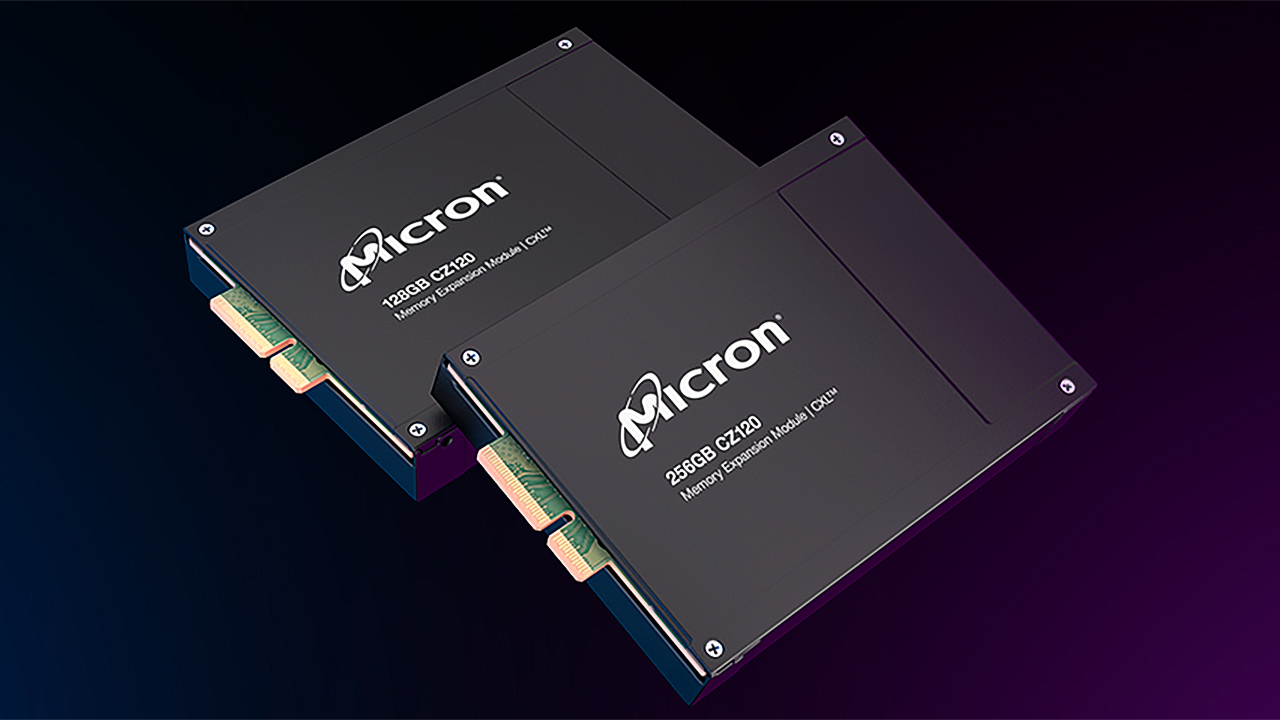Micron Unveils 128GB and 256GB CXL 2.0 Expansion Modules
Micron's CX120 CXL 2.0 memory expansion modules promise inexpensive performance upgrade for AMD and Intel-based servers.

Micron on Monday introduced its CZ120 memory expansion modules that comply with the CXL 2.0 Type 3 specification and feature a PCIe 5.0 x8 interface. The modules are designed to expand DRAM capacity and bandwidth for servers that need more high-performance memory to run workloads that require loads of RAM, including in-memory databases and software-as-a-service. Samples of the modules are now available to interested parties.
The Micron CZ120 memory modules are equipped with 128GB and 256GB of memory, which is in line with what typical RDIMMs offer. The expansion modules come in a E3.S 2T form-factor with a PCIe 5.0 x8 interface and are based on Microchip's SMC 2000 controller compliant with the CXL 2.0 Type 3 standard as well as Micron's memory chips made using the company's 1α (1-alpha) DRAM production node.
From a performance point of view, Micron's CZ120 CXL 2.0 memory expansion modules provide bandwidth of up to 36 GB/s (measured by running MLC workload with 2:1 read/write ratio on a single CZ120 memory expansion module) and are not significantly slower than DDR5-4800 RDIMMs with 128GB and 256GB memory onboard that offer a peak bandwidth of 38.4 GB/s.
Modern servers based on AMD's 4th Generation EPYC 'Genoa' CPU with a 12-channel DDR5-4800 memory subsystem feature memory bandwidth of up to 460.8 GB/s per socket, whereas machines powered by Intel's 4thGeneration Xeon Scalable processor featuring an 8-channel DDR5-4800 DRAM system can boast with a 307.2 GB/s. While in both cases CPUs get ample of bandwidth, there are workloads that need more DRAM and higher bandwidth and CXL 2.0 memory expansion modules are designed for this very purpose.
Micron claims that the addition of four 256GB CZ120 memory expansion modules to a machine equipped with 12 64GB DDR5 RDIMMs (768GB) can enable a 24% greater memory read/write bandwidth per CPU than servers using RDIMM memory alone, whereas additional memory capacity will enable server to process up to 96% more database queries per day.
"Micron is advancing the adoption of CXL memory with this CZ120 sampling milestone to key customers," said Siva Makineni, vice president of the Micron Advanced Memory Systems Group. "We have been developing and testing our CZ120 memory expansion modules utilizing both Intel and AMD platforms capable of supporting the CXL standard. Our product innovation coupled with our collaborative efforts with the CXL ecosystem will enable faster acceptance of this new standard, as we work collectively to meet the ever-growing demands of data centers and their memory-intensive workloads."
Micron has not disclosed when it plans to ship its CZ120 memory expansion modules commercially and how much will they cost. It is likely that the products will be deployed sometimes in 2024 after interested parties validate and qualify them, though some companies may deploy them sooner, whereas other will likely test them for longer periods, depending on workloads.
Get Tom's Hardware's best news and in-depth reviews, straight to your inbox.

Anton Shilov is a contributing writer at Tom’s Hardware. Over the past couple of decades, he has covered everything from CPUs and GPUs to supercomputers and from modern process technologies and latest fab tools to high-tech industry trends.